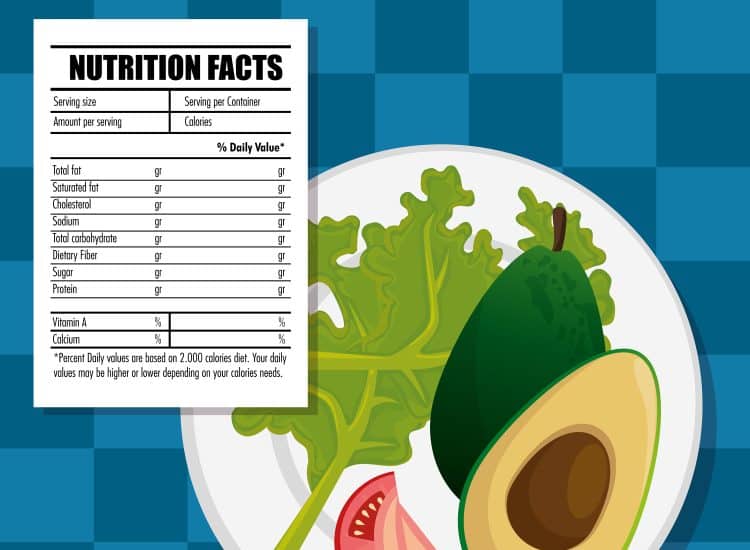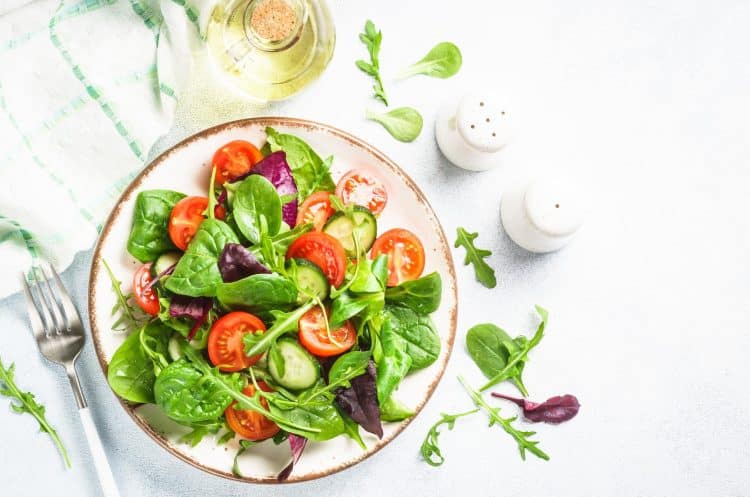Salad Nutrition Calculator
Crafting the perfect salad for your dietary needs? Use our Salad Nutrition Calculator to swiftly gauge the calorie and nutrient content. Dive in, add your ingredients, and align your tasty blend with your goals!
Result:
| Nutrition information | |
|---|---|
| Nutrients | Total amount |
| Calorie | 283 |
| Fat | 283 |
| Cholesterol | 283 |
| Sodium | 283 |
| Carbohydrates | 283 |
| Fiber | 283 |
| Sugars | 283 |
| Protein | 283 |
| Ingredients | |
|---|---|
Whether you want to lose weight, build muscle, or just be healthier, your diet matters. After all, as the famous saying goes, you are what you eat!
It’s generally accepted that plant foods (vegetables, fruits, whole grains, seeds, nuts, etc.) are particularly beneficial. That’s because they’re packed with the vitamins, minerals, and fiber your body needs to function properly.
However, getting enough of these crucial foods is not always easy. That’s because they can sometimes lack flavor or be boring, and given the choice, most people would rather eat fruit roll-ups than actual fruit.
The good news is that, regardless of which diet you are following, there is a way to make plant foods much more appealing. We’re talking about salads. Salads are easy to put together, portable, and highly nutritious. You can adapt a salad to almost any nutritional goal, from weight loss to muscle building. And they taste delicious.
Of course, you need to make sure your salad matches your needs, which is where our salad calculator comes in. Use it to determine your salad’s nutritional and macronutrient values and that it matches your dietary requirements.
Level Up Your Fitness: Join our 💪 strong community in Fitness Volt Newsletter. Get daily inspiration, expert-backed workouts, nutrition tips, the latest in strength sports, and the support you need to reach your goals. Subscribe for free!
So, keep reading to discover how to use this handy tool.
What is the Salad Nutrition Calculator?

Your food intake needs to align with your nutritional goals. Depending on what you are trying to achieve, failing to consume enough calories and macronutrients (protein, carbohydrates, and fats) can be as detrimental as consuming too many. Like Goldilocks’ porridge, your diet must be “just right” to optimize your progress.
Our easy-to-use Salad Nutrition Calculator allows you to quickly determine the calorie and macro content of your meal so you can ensure it meets your needs.
Unfortunately, a lot of salads, such as those from convenience stores and fast-food restaurants, are not as healthy as they might appear. Many contain fattening or unhealthy ingredients like hydrogenated oil dressings, large amounts of salt, processed meats, and even sugar.
As such, it’s usually best to make your own.
Using this Salad Nutrition Calculator, you can be confident that your next salad aligns with your diet and is as healthy as you believe it is.
How to Use the Salad Nutrition Calculator
Our Salad Nutrition Calculator is very easy to use. Just follow these step-by-step instructions to determine the calorie and macronutrient values of your meal.
- From the lettuce dropdown menu, select what type of salad leaves your meal contains, e.g., romaine, kale, spinach, etc.
- Enter the quantity in grams.
- Repeat for every lettuce ingredient.
- Next, from the choppings dropdown menu, choose your first topping. Your options include bacon, croutons, grapes, cucumber, etc.
- Enter the quantity in grams.
- Repeat for every choppings ingredient.
- From the next dropdown menu, select your protein Your options include turkey, tofu, and tuna.
- Enter the quantity in grams.
- Repeat for every protein ingredient.
- Finally, choose your salad dressing, with options including ranch, salsa, oil, and vinegar.
- Enter the quantity in grams.
- Repeat for every dressing.
- Hit enter, and your results will be displayed in the box below.
Note: Leave any unused category blank. For example, if you don’t use a dressing, just ignore that part of the calculator.
Interpreting your Results
After hitting enter, the calculator will analyze and reveal the nutritional content of your salad. This includes:
- Calories
- Fat
- Cholesterol
- Sodium
- Carbohydrates
- Fiber
- Sugars
- Protein
In addition, you’ll also see a list of your ingredients and the amounts entered. You can then use this information to finetune your meal to precisely match your nutritional needs, e.g., adding more protein or subtracting fat.
How to Create a Healthier Salad

Contrary to what many people think, salads are not automatically healthy. While plant foods are generally rich in vitamins, minerals, and fiber, it doesn’t take much to cancel out their nutritional benefits with unhealthy toppings and dressings.
With that in mind, here are some handy tips for making healthier salads:
- Use fresh ingredients: Nothing ruins a salad like limp lettuce or squishy tomatoes. Fresh ingredients also tend to be more nutritious.
- Opt for Lean Proteins: Choose lean proteins like grilled chicken, turkey, or tofu to keep the calorie count low.
- Avoid Processed Meats: Steer clear of processed meats like salami or bacon, which often contain high levels of sodium and saturated fats.
- Be Mindful of Dressings: Opt for dressings made from olive oil, lemon juice, or vinegar, and avoid those that contain sugar or trans fats.
- Limit Cheese and Nuts: While delicious, cheese and nuts are calorie-dense. Use them sparingly.
- Be Mindful of Add-Ons: Croutons, dried fruits, and other add-ons can quickly increase the calorie count.
- Measure Your Ingredients: Use a food scale or measuring cups to keep track of portion sizes.
- Wash Your Greens: Always wash salad leaves thoroughly to remove any pesticides or contaminants.
- Go for Color: Incorporate a variety of colorful vegetables to ensure you’re getting a range of nutrients.
- Include Healthy Fats: Incorporate sources of healthy fats like avocado or flaxseeds for better nutrient absorption.
- Don’t Be Afraid to Experiment: Try new ingredients to add an extra dimension to your meals. Salads don’t have to be boring!
- Prep Ahead: Cut veggies in advance and store them in airtight containers to make salad assembly quicker and easier.
- Serve Carbs on The Side: If appropriate for your diet, increase the caloric value of your salad with a serving of carbs on the side, e.g., rice, quinoa, or wholegrain bread.
- Keep Dressing Separate: If you’re preparing a salad for later, keep the dressing separate to avoid sogginess.
- Watch the Salt: Opt for low-sodium/sodium options whenever possible, as too much salt can be unhealthy. Canned or pickled ingredients are typically high in salt.
- Chew Slowly: Take your time eating to help with digestion and to better recognize when you’re full.
- Stay Hydrated: Drink water alongside your salad to aid digestion and help you feel full.
Use these tips to help you create delicious, healthy salads every time. Let’s make boring, tasteless salads a thing of the past!
Salad Nutrition Calculator FAQ
Do you have a question about our salad calculator or healthy eating in general? Check the following FAQ for answers!
1. Do I have to eat salads to be healthy?
While salads can be part of a healthy diet, you don’t need to eat salad if you don’t want to. You can eat your plant foods in any form to gain their benefits. For example, if you don’t like salads, you can have vegetable-based soups and smoothies, roasted vegetables, boiled vegetables, and grilled vegetables.
Remember, too, that not all salads are healthy. Too many processed, high-calorie toppings and dressings can turn your healthy vegetables into something far less good for you.
Level Up Your Fitness: Join our 💪 strong community in Fitness Volt Newsletter. Get daily inspiration, expert-backed workouts, nutrition tips, the latest in strength sports, and the support you need to reach your goals. Subscribe for free!
2. Will eating more salads help me lose weight?
Salads can help you lose weight, provided they contribute to a calorie deficit, where your calorie intake is less than your expenditure. However, if you slather your salad in high-calorie dressing and toppings, you could end up consuming far more calories than you realize, resulting in weight gain rather than weight loss.
And that’s where our Salad Nutrition Calculator comes in; you can use it to make sure your supposedly healthy salad won’t inadvertently derail your weight loss efforts.
3. What are the best protein options for a healthy salad?
Protein makes salads more satisfying and enjoyable. Adding protein to your salad adds flavor and can help with muscle building and fat loss. The best protein sources for a healthy diet are lean, natural, and tasty. Good options include:
- Chickpeas: A plant-based protein that’s rich in fiber and nutrients, adding both texture and flavor to your salad.
- Egg Whites: For those who want to keep it simple and super lean.
- Grilled Chicken Breast: A classic choice that’s lean and high in protein.
- Hard-Boiled Eggs: A convenient option that’s rich in protein and easy to add to any salad.
- Lentils: A plant-based protein that’s also rich in fiber, making your salad more satisfying.
- Quinoa: A grain that’s high in protein and provides a different texture.
- Salmon: Rich in omega-3 fatty acids, it’s a flavorful and healthy option.
- Shrimp: Low in calories and high in protein, they add a seafood twist to your salad.
- Tempeh: A fermented plant-based protein that’s easy to digest and contains gut-friendly probiotics.
- Tofu: A plant-based option that’s versatile and can absorb flavors well.
- Tuna: Either fresh or canned in water, it’s a lean protein source that’s also rich in omega-3s.
- Turkey Breast: Similar to chicken but with a different flavor, turkey is also lean and high in protein.
With 12 different protein sources to choose from, your salads need never be boring, and you can mix and match flavors and textures to suit your mood and tastes.
4. How can I make my salads more filling without adding extra calories?
Most salad vegetables are high in filling fiber and water but low in carbs and calories. As such, you can have a huge, filling bowl of salad without ingesting a lot of unwanted energy. Use lean proteins and avoid high-fat toppings, and your salad should be low in calories yet satisfying to eat.
Good foods you can use to bulk up your salad without adding many extra calories include:
- Arugula: Peppery and rich in antioxidants, it’s a great low-calorie leafy green.
- Bell Peppers: Colorful and low in calories, they add a sweet crunch to your salad.
- Carrots: High in fiber and beta-carotene but low in calories.
- Cherry Tomatoes: Low in calories and high in antioxidants.
- Cucumber: High in water content and low in calories, making it a refreshing addition.
- Kale: Another nutrient-dense leafy green that’s low in calories but high in vitamins.
- Mushrooms: Low in calories and a good source of minerals.
- Radishes: Spicy and crunchy, they add flavor without many calories.
- Red Cabbage: Adds color and is high in fiber but low in calories.
- Romaine Lettuce: Another leafy green that’s low in calories but provides a good amount of fiber.
- Spinach: A nutrient-dense leafy green that’s low in calories but high in vitamins. It will also make you stronger – just ask Popeye!
- Zucchini: Low in calories and a good source of fiber and water content.
5. Are store-bought salad dressings healthy options?
Store-bought salad dressings vary enormously in quality and healthfulness. Some are loaded with trans fats, salt, and sugar and contain hundreds of calories per serving. For example, commercial ranch dressing is typically made from mayonnaise, sour cream, and buttermilk. An average two-tablespoon serving contains 140-160 calories.
In contrast, vinaigrette made with olive oil and vinegar or lemon juice contains as few as 40-50 calories, depending on the ratio of oil to vinegar. You can make vinaigrette yourself, adding any herbs you wish to make it more flavorsome.
Long story short, some store-bought salad dressings are pretty healthy and don’t contain too many calories, but others are much less so. Check the nutritional information on the bottle for specific calorie values per serving. Note, too, that most people use more than the standard amount, increasing their caloric intake even more. So, make sure you measure and don’t just pour it on.
6. Can I meal-prep salads in advance without them getting soggy?
Nobody likes soggy salads, but that’s a common problem for people who eat salads prepared in advance.
To avoid this, keep the dressing separate until you’re ready to eat. Use airtight containers to store cut veggies and greens, which helps maintain their freshness. If you’re using ingredients that release water, like tomatoes or cucumbers, consider keeping them in a separate container as well.
These simple steps can make a big difference in keeping your salad crisp and enjoyable.
7. Is it necessary to wash pre-packaged salad greens?
Yes, washing pre-packaged salad greens is generally advisable, even if they are labeled as “pre-washed” or “ready-to-eat.”
The quality of the water used to wash the greens is unknown, and there is also a risk of cross-contamination during packaging and transport. Worse still, there have been E. coli outbreaks linked to pre-packaged salads, so it’s better to be safe than sorry.
Quick Step-by-Step on How to Wash and Dry Salad Greens:
- Fill a large bowl with cold water.
- Submerge the salad greens in the water and gently swish them around to loosen any dirt or debris.
- Drain the water and repeat the process if necessary.
- Use a salad spinner to remove excess water, or pat the greens dry with a clean towel.
Taking these extra steps can provide an added layer of safety and peace of mind.
Want to know more about salads, healthy eating, or diets? Feel free to post your question in the comments section below, and we’ll get back to you ASAP!
Wrapping Up
Salads can be part of almost any diet, from bulking to fat loss. However, it would be a mistake to assume all salads are healthy, as the quality and quantity of the ingredients will significantly affect the macro and calorie content of your meal.
Make sure your salads align with your nutritional goals with our easy-to-use Salad Nutrition Calculator. Just enter your ingredients and quantities, and it will tell you how much protein, carbohydrate, fat, sugar, salt, fiber, and cholesterol your meal contains, plus how many calories.
Salads can add an extra healthy dimension to your diet, whether you have them as main meals or on the side. They’re quick and easy to prepare, portable, and seldom require any cooking. They’re a great way to increase your intake of beneficial plant foods.
So, gather your ingredients, enter them into the calculator, and enjoy your salad safe in the knowledge it will take you a few steps closer to your fitness and nutrition goals.








